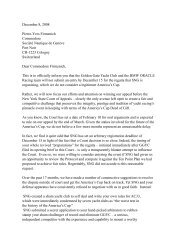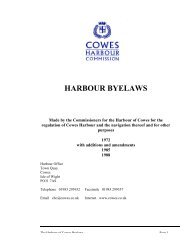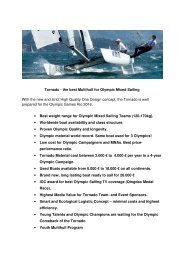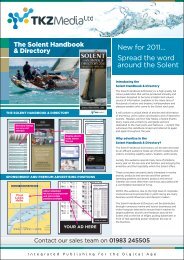The legal aspects of race, training and event management - rya
The legal aspects of race, training and event management - rya
The legal aspects of race, training and event management - rya
You also want an ePaper? Increase the reach of your titles
YUMPU automatically turns print PDFs into web optimized ePapers that Google loves.
SECTION 5: Special Considerations for Children <strong>and</strong> Young PersonsSECTION 5: Special Considerations for Children <strong>and</strong> Young PersonsHowever, much will depend on the age <strong>of</strong> the young person in question <strong>and</strong> hislevel <strong>of</strong> experience. <strong>The</strong> following general guidelines should assist in establishingthe right level <strong>of</strong> supervision <strong>and</strong> safety rules.Children below the age <strong>of</strong> 11 - Inexperienced sailorsWhere this age group is concerned, the st<strong>and</strong>ard <strong>of</strong> care is at its highestparticularly where the parents or guardians are not in immediate attendance (or inthe case where the parents or guardians are themselves inexperienced). Constantsupervision is appropriate, <strong>and</strong> particular care must be shown in not exposing thechild to danger. This would apply equally whether afl oat, ashore, or at the water’sedge. Volunteers are effectively in loco parentis <strong>and</strong> will be expected to show thesame st<strong>and</strong>ard <strong>of</strong> care, as would reasonably careful <strong>and</strong> knowledgeable parents inthe same circumstances.Children below the age <strong>of</strong> 11 - Experienced sailorsFor this group the same principles as to supervision will apply, except that thechildren may be expected to cope with more diffi cult weather conditions. Ofcourse a balance must be struck between over-protectiveness <strong>and</strong> permittingchildren to take foolhardy risks. It is unlikely to be acceptable for a club or <strong>of</strong>fi cial toclaim that the child willingly accepted the risk.Children 11-13 - Inexperienced sailors<strong>The</strong> same principles will apply as for younger children while afl oat, although a lowerlevel <strong>of</strong> supervision would be expected while ashore or at the water’s edge.Children 11 - 13 - Experienced sailorsChildren in this age group will vary considerably in having suffi cient maturity tomake decisions about risk taking particularly when peer pressure is involved.While a degree <strong>of</strong> supervision is still expected, they can be reasonably expected tobe self-reliant both afl oat <strong>and</strong> ashore. However there will still be a tendency amongsome to underestimate the risks involved. Consideration should also be given as towhether a child is taking risks because <strong>of</strong> peer pressure.Young people 14 - 18 - Inexperienced sailors<strong>The</strong> same principles will apply as for younger sailors while afl oat, although a verymuch lower level <strong>of</strong> supervision would be expected while ashore or at the water’sedge.Young people 14 - 18 - Experienced sailorsOnce over the age <strong>of</strong> 14, depending on the mental maturity <strong>of</strong> the individual, youngpeople can be expected to make sensible decisions about their exposure to risk.By the age <strong>of</strong> 16 or so they would be equated by the courts to adults, <strong>and</strong> specialconsiderations as to the supervision <strong>of</strong> young persons would be unlikely to apply.It should be noted however that the age <strong>of</strong> <strong>legal</strong> majority is 18, so any contractualdocuments, including exclusion <strong>of</strong> liability clauses, would probably be <strong>of</strong> no effectin law <strong>and</strong> should not be relied upon.Organised racing or other group <strong>event</strong>sA special st<strong>and</strong>ard <strong>of</strong> care must be shown in the following matters:• Acceptance <strong>of</strong> entries, having regard to:-■ age <strong>and</strong> experience <strong>of</strong> competitors;■ expected number <strong>of</strong> competitors;■ available patrol boats;■ anticipated weather <strong>and</strong> tidal conditions.• <strong>The</strong> decision to cancel, postpone, or continue with racing in the light <strong>of</strong> theforegoing factors.• Provision <strong>and</strong> maintenance <strong>of</strong> adequate patrol boats (<strong>and</strong> in this regard itis even more important to provide adequate cover). (See Section 2).• Enforcement <strong>of</strong> appropriate safety regulations.It is impossible to lay down criteria or guidelines that will be <strong>of</strong> general application,for example a ratio <strong>of</strong> patrol boats to competitors. Weather conditions, age,experience <strong>and</strong> competence <strong>of</strong> competitors etc vary so much from one club toanother <strong>and</strong> from one <strong>event</strong> to another that it must be for the sailing committee<strong>of</strong> each club <strong>and</strong> the organisers <strong>of</strong> each <strong>event</strong> to decide what safety regulationsshould exist, what systems should be employed for their enforcement, <strong>and</strong> whensuch regulations should be imposed <strong>and</strong>/or waived. In making these decisions, thecommittee need not attempt to forestall or remove every single area <strong>of</strong> risk; ratherthey must take a common-sense approach to practical safety rules that will notbe so onerous as to stifl e the interest <strong>of</strong> young people or pr<strong>event</strong> them sailing inadverse conditions but will cover the most obvious areas <strong>of</strong> risk. As we have seen,the st<strong>and</strong>ard will vary accordingly to the age <strong>and</strong> experience <strong>of</strong> the competitors.Training activitiesBy defi nition inexperienced young people are the most vulnerable class <strong>of</strong> peopleto take to the water. Since young novices are also the least able to assess thedegree <strong>of</strong> risk to which they are exposing themselves, instructors responsible forthem require a particularly high st<strong>and</strong>ard <strong>of</strong> care in this regard.While the previous paragraphs apply in most cases as much to <strong>training</strong> activitiesas to racing, in the <strong>event</strong> <strong>of</strong> an accident resulting from lack <strong>of</strong> proper precautionsbeing taken, a court may have less sympathy for an instructor <strong>and</strong> the club ororganisation to which he is answerable.16 17







